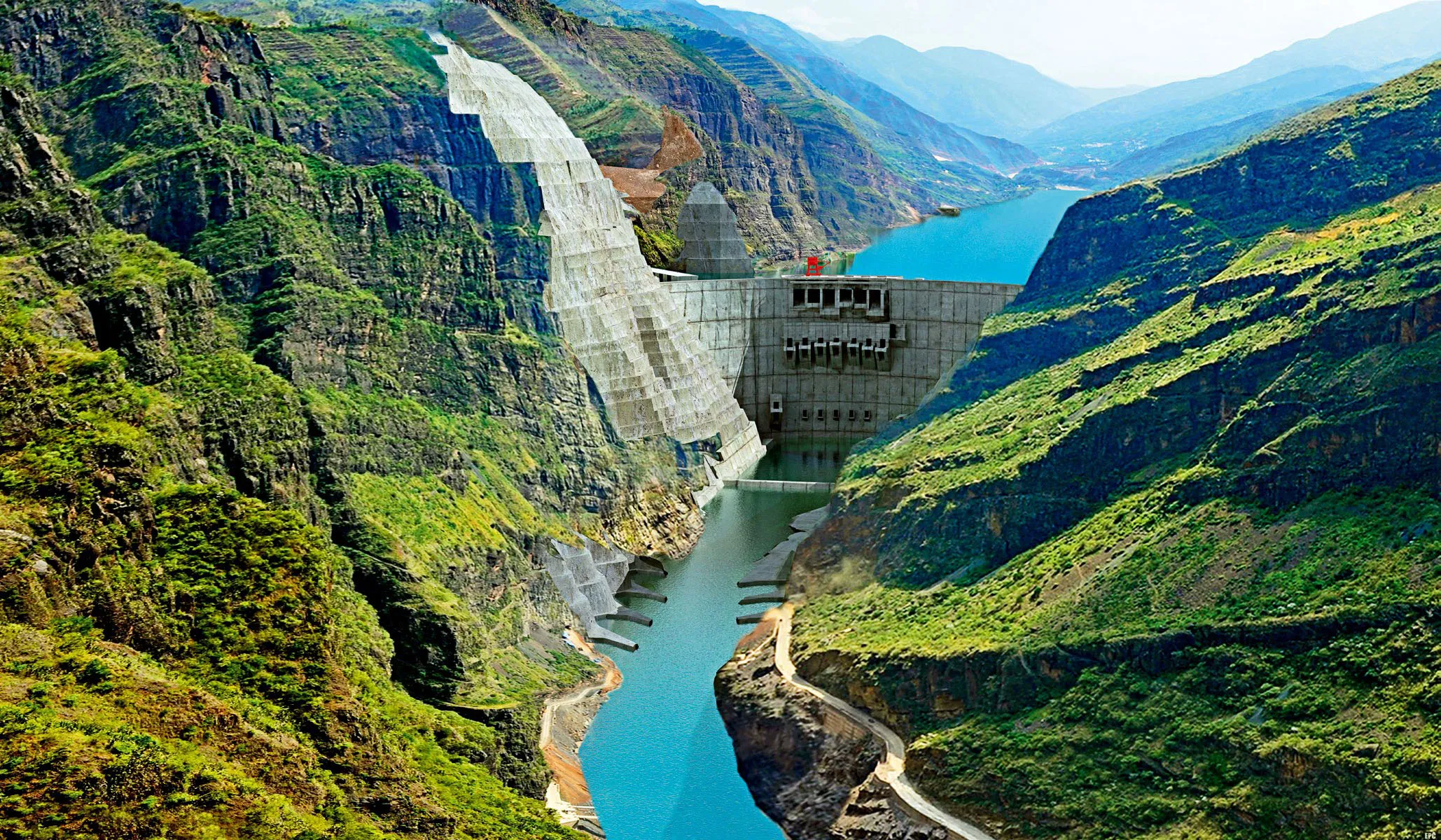BAIHETAN TO BREAK WORLD RECORDS
2017-09-18ByTanXingyu
By Tan Xingyu
BAIHETAN TO BREAK WORLD RECORDS
By Tan Xingyu
Hydropower station in southwest China, which is currently under construction, is set to transform China’s power generation industry

Top: A rendering of how the Baihetan Hydropower Station will appear when finished.
Baihetan is scheduled to close dam gates in May 2022, and the first group of its generators will begin operating within the year.
289
The arch dam height, in meters, making it the world’s third highest
1million
The dam’sunit capacity in kilowatts, the largest in the world
The Baihetan (White Crane Beach) Hydropower Station located on the lower reaches of the Jinsha River straddles Ningnan County of Sichuan Province and Qiaojia County of Yunnan Province. A gigantic project built by China Three Gorges Corporation, it will have an installed capacity of 16 million kilowatts upon completion, second only to the Three Gorges hydropower complex and overtaking Itaipu, the world’s current No. 2, by 2 million kilowatts. Baihetan is the world’s largest hydropower plant currently under construction.
Colossal Project
Baihetan holds several world records apart from its size and overall capacity. It has the largest number of underground caverns among hydropower stations, the largest unit capacity (1 million kilowatts), and the strongest earthquake-resistance for 300-meter-grade dams in the world. It is also unrivaled globally in terms of its scale of cylinder tailrace surge shafts and non-pressure spillway tunnels as well as the use of low-heat cement across the entirety of a 300-meter-grade dam.
What’s more, Baihetan ranks second in the world in terms of installed capacity (16 million kilowatts) and total hydraulic thrust (16.5 million tons). Its arch dam, at 289 meters, is the world’s third-highest, and its flood-discharge power is the world’s third-largest. All in all, it is one of the most technically demanding projects of its kind in the world.
Baihetan is located in a quake-prone area. The valley that surrounds it is of an asymmetrical shape that consists of hard but crumbly rocks, making the terrain challenging for both designers and builders. Additionally, the narrow riverbeds in mountains and canyons make the construction among the most difficult in the history of hydropower projects.
To ensure the quality of the project, China Three Gorges Corporation employs a number of advanced technologies. Starting with Xiluodu, another hydropower plant on the Jinsha River built by China Three Gorges Corporation, a“smart construction system”has been used, implementing digital technologies such as underground sensors to collect data and monitor the entire construction process.
According to Fan Qixiang, deputy general manager of China Three Gorges Corporation, advanced intelligent analysis and control technologies can reduce various factors of uncertainty in a complex building environment amid changing human activities, allowing the construction to proceed in a stable and orderly fashion. They can also provide real-time analysis of the situation, forecast future development and find solutions accordingly. This fulldimension control of the whole construction process ensures project safety, quality andefficiency.
Baihetan’s unit generator capacity, at 1 million kilowatts, is by far the world’s largest. The 16 generating units to be installed at the station will herald the world’s hydropower sector into the “1,000-MW” age.
Baihetan is scheduled to close dam gates in May 2022, and the first group of its generators will begin operating within the year. Full operation will begin by the end of 2022. With an annual output of 62.443 billion kilowatt-hours, the station is pivotal to China’s plan to transport electricity from its western provinces to eastern regions. It is certain to increase the dynamism of the nation’s sources of power.
The station will also beef up the flood-prevention system along the Yangtze River, improve local shipping conditions and boost the social and economic development of the Yangtze Economic Belt. Additionally, it will boost the export of Chinese machinery equipment and engineering technologies.

China Three Gorges Corporation holds a ceremony to mark the start of construction of the Baihetan hydropower project on Aug. 3, 2017.
Green Energy
Environmental awareness has been growing in China in the past few years as the nation’s economy steadily grows. The possible impact on the local environment of a mega project like Baihetan is of great concern to the public.
“As soon as the planning kicked off in 2008, we listed dozens of possible environmental issues and nearly 100 countermeasures in a report we published,” said Sun Zhiyu, chief of environmental protection at China Three Gorges Corporation. Over the course of two decades of survey and debate on the environmental feasibility of the project, the corporation studied the vulnerabilities of the ecosystem at three levels — the entire drainage area, the section of the river where the project is located as well as the site of the project. By way of careful planning, close monitoring and targeted protection and rehabilitation, the company devised a full set of sound environmental preservation measures for river development.
Shen Guofang, a member of the Chinese Academy of Engineering, explained that the impact of hydropower exploitation on the natural environment must be considered from the perspective of not only the region directly concerned but also the drainage area as a whole. For the former, Shen said, the impact is limited. In the case of Baihetan, after the reservoir builds up at the station, increases in evaporation will boost the growth of local vegetation and consequently extend green coverage. From the perspective of the entire drainage area, the station, with a 7.5 billion cubic meter water storage capacity, has tremendous environmental benefits in terms of flood prevention.
Sun Changping, Party secretary and vice general manager of the China Three Gorges Projects Development Company, said that the electricity to be generated by Baihetan can serve as a substitute for 62.443 billion kilowatt-hours of coalfired power every year, saving 19.68 million tons of standard coal. Such a reduction indicates a drop in carbon dioxide emissions of 51.6 million tons, a drop in sulfur dioxide of 170,000 tons, a drop in nitrogen oxide of 150,000 tons and a drop in dust and soot of 220,000 tons.
Richard M. Taylor, executive director of International Hydropower Association, is optimistic about the positive impact Baihetan will have on the local economy.
“I believe its economic benefits will not be confined to one or two aspects,” Taylor said. “The construction of a giant project can invigorate all productive activities in a region. In poverty-stricken areas, such construction helps to increase employment rates and creates training and educational opportunities for local workers. Thus, the impact of such a project goes beyond the local economic sector into a broader context, sometimes even influencing the socioeconomic development of an entire nation.”
